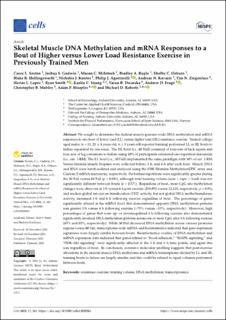| dc.description.abstract | We sought to determine the skeletal muscle genome-wide DNA methylation and mRNA responses to one bout of lower load (LL) versus higher load (HL) resistance exercise. Trained college-aged males (n = 11, 23 ± 4 years old, 4 ± 3 years self-reported training) performed LL or HL bouts to failure separated by one week. The HL bout (i.e., 80 Fail) consisted of four sets of back squats and four sets of leg extensions to failure using 80% of participants estimated one-repetition maximum (i.e., est. 1-RM). The LL bout (i.e., 30 Fail) implemented the same paradigm with 30% of est. 1-RM. Vastus lateralis muscle biopsies were collected before, 3 h, and 6 h after each bout. Muscle DNA and RNA were batch-isolated and analyzed using the 850k Illumina MethylationEPIC array and Clariom S mRNA microarray, respectively. Performed repetitions were significantly greater during the 30 Fail versus 80 Fail (p < 0.001), although total training volume (sets × reps × load) was not significantly different between bouts (p = 0.571). Regardless of bout, more CpG site methylation changes were observed at 3 h versus 6 h post exercise (239,951 versus 12,419, respectively; p < 0.01), and nuclear global ten-eleven translocation (TET) activity, but not global DNA methyltransferase activity, increased 3 h and 6 h following exercise regardless of bout. The percentage of genes significantly altered at the mRNA level that demonstrated opposite DNA methylation patterns was greater 3 h versus 6 h following exercise (~75% versus ~15%, respectively). Moreover, high percentages of genes that were up- or downregulated 6 h following exercise also demonstrated significantly inversed DNA methylation patterns across one or more CpG sites 3 h following exercise (65% and 82%, respectively). While 30 Fail decreased DNA methylation across various promoter regions versus 80 Fail, transcriptome-wide mRNA and bioinformatics indicated that gene expression signatures were largely similar between bouts. Bioinformatics overlay of DNA methylation and mRNA expression data indicated that genes related to “Focal adhesion,” “MAPK signaling,” and “PI3K-Akt signaling” were significantly affected at the 3 h and 6 h time points, and again this was regardless of bout. In conclusion, extensive molecular profiling suggests that post-exercise alterations in the skeletal muscle DNA methylome and mRNA transcriptome elicited by LL and HL training bouts to failure are largely similar, and this could be related to equal volumes performed between bouts. | en_US |
